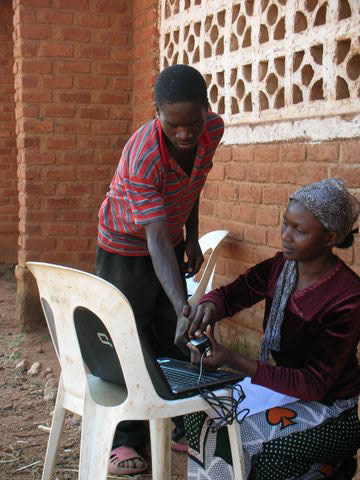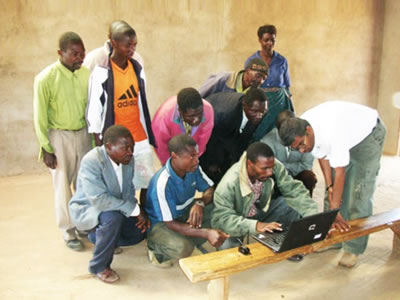Microfinance breakthrough: Dean Yang uses fingerprints to boost microlending in Malawi

Eight years ago, development economist Dean Yang spent a week in Malawi visiting microfinance institutions, the banks and credit unions that provide financial services to some of the world's most vulnerable citizens.
Yang, who works to combat extreme global poverty, was trying to understand the constraints these institutions faced as they sought to extend more loans and services to poor people in rural areas while recovering a reasonable level of profit, and growing their businesses, along the way.
"There's very little microlending in rural Malawi; it's just very hard to make it work," says Yang. "Ninety percent of the people live on smallholder farms in places that basically have no electricity or running water or financial services or government interaction at all."
During one of these visits, Yang asked a manager at the Malawi Rural Finance Corporation, which lends almost exclusively to paprika farmers just north of Lilongwe, if he could think of anything that might improve the bank's business situation.
The manager's reply was unexpected: fingerprinting borrowers.
Fingerprinting, of course, is increasingly used as identity protection in developed economies. It's long been used for forensic analysis in the criminal justice system. And centuries ago, it was used to seal contracts—parties to the contract would press their fingertips into clay.
But the idea of fingerprinting for microlending was new, and had real potential, says Yang.
Big work for small loans
One of the thorniest problems microfinance institutions face, explains Yang, is asymmetric information.
Customers know a great deal about their own creditworthiness, and have a good sense of how creditworthy their friends and family are. But in a region where very few people have government-issued photo IDs, let alone collateral or credit histories, banks know almost nothing about prospective borrowers.
To circumvent this issue, officers who wish to extend loans in rural areas—even small loans of just $100 per person—are forced to build extensive personal networks. They travel to a village and get to know its leaders, assemble groups of potential borrowers, get to know each of them by name and face, ask around to assess their reputations—all before making a single loan.
"That's pretty time-consuming for a loan officer," says Yang. "And then if he or she gets transferred, that knowledge is lost to the institution."
The thing is, small loans can do big things for poor people in rural areas. They can be used to purchase livestock for farms, fertilizers to increase crop yields, or new equipment to improve productivity. They can allow borrowers to get training that will prepare them for careers, to purchase wholesale items for a market stall, to improve their homes and businesses, and more.
Why fingerprinting?
 |
So small loans—even though they're risky and unprofitable for lenders—really matter. But why fingerprinting?
Like a government-issued ID, says Yang, fingerprints are unique to their owners, and can be used to identify borrowers and track their credit history over time. But unlike a government-issued ID, fingerprints require no cumbersome application process, and they can't really be lost, stolen, or forgotten.
To test the concept, Yang and coauthors Xavier Giné (World Bank) and Jessica Goldberg (PhD '11) ran a randomized trial (similar in structure to medical trials and a methodology once rare, but increasingly common, in the social sciences).
When the Malawi Rural Finance Corporation decided to extend loans to 3,206 paprika farmers in 214 farming groups, Yang's team, including project manager Santhosh Srinivasan (MPP '07), conducted a baseline survey of the farmers, then rolled out the experiment.
All borrowers were required to attend a presentation on the value of building a good credit history. Then half of the borrowers—those in groups randomly assigned to the treatment—were fingerprinted in the presence of a microfinance loan officer.
After their names, demographic information, and fingerprints were collected, a single farmer was chosen at random to have his right thumb rescanned. The entire club watched on as the computer identified him by name, displaying his demographic information.
"Most of these borrowers were in really deep, rural areas of Malawi; rich people in their villages perhaps had access to a TV, but nobody had ever seen a fingerprint scanner," says Srinivasan. "The fact that we could now identify someone based on their thumbprint... was all very alien."
The most interesting part, though, is what came next. For the borrowers with the highest default risk—roughly 20 percent of those who took out loans—fingerprinting significantly increased repayments.
Two months after the paprika harvest, high-risk borrowers in the control group had repaid only 67 percent of their loans while those who had been fingerprinted repaid 92 percent.
Fingerprinted borrowers, says Yang, seemed to self-regulate. They took out smaller loans, spent more of the money on agricultural inputs like fertilizers and seeds, cultivated more land, and focused more of their farming time on the paprika cash crop.
Yang did a cost-benefit analysis, as well. And even with the cost of implementation— including laptops, USB scanners, software, and staff time—the benefits outweighed the costs more than two to one.
Scaling it up across the nation
While the short term benefits of fingerprinting were significant, Yang believes that the long-term benefits could be even better as borrowers build credit, secure lower interest rates, and perhaps even increase their incomes and capital.
Srinivasan, who stayed in Malawi for an additional six months beyond the survey and remained in contact with some of the villagers and loan officers, saw some of this first hand.
"A number of the farmers who were part of this program received loans again the following season," he says. "They had proven themselves, established a credit history, and the bank was viewing that favorably."
With a $1 million scale up grant from Development Innovation Ventures at USAID, Yang and his colleagues at Innovations for Poverty Action and the World Bank are in the process of testing whether these results hold true in a much larger sample.
In collaboration with three of Malawi's biggest microfinance institutions—together, these institutions serve 75 percent of Malawi's borrowers—they are rolling out a nationwide scale up. They're giving training and technology to half the loan officers at these institutions, and those loan officers will fingerprint and register all of their borrowers. Along the way, Yang and his colleagues will monitor their registrations and data collection.
"We want to show that the technology can work," says Yang, "but we also want to see how the technology changes things."
Does it continue to raise repayment rates? Does it make the participating loan officers' portfolios more profitable? Does it allow them to expand their portfolios—to attract new customers, and riskier customers? Those customers, says Yang, might be more vulnerable, more likely to be living in poverty.
"Even though, in general, poorer clients aren't a good business risk for the microfinance institution, maybe now that there's less risk of default, they can bring them into the system and give them credit," says Yang.
Yang is also interested in what happens with the borrowers. He wants to see if the results from his pilot study still hold true—that borrowers self-regulate, taking smaller loans, investing more time and resources in their cash crops. But he also wants to see if their incomes rise.
 |
"At first blush, you would think, well why would fingerprinting somebody raise their income?" he says. "It seems kind of crazy to imagine that, but if they really are more disciplined about their use of the loans, it might lead to higher income."
Breaking new ground
Yang's study is not only addressing a massive challenge in microfinance and international development, it's also providing rigorous empirical evidence of the importance of personal identification for credit market efficiency.
Carly Farver (MPP '14), director of the Malawi field office of Innovations for Poverty Action, says that the United Nations Development Program recently used Yang's study to argue for the inclusion of biometrics in Malawi's first-ever national ID registration.
Using fingerprinting technology to address microfinance challenges was definitely something of a breakthrough, says Yang, who credits field work, and the Malawi Rural Finance Corporation, for the insight and opportunity.
"It's hard to come up with these things just sitting at your desk in Ann Arbor, or in any U.S. university, and figure out what kind of development initiative might work," he says. "I probably get my best ideas being out in the field and talking with real people on the ground."
By Erin Spanier for State & Hill, the magazine of the Gerald R. Ford School of Public Policy
Below is a formatted version of this article from State & Hill, the magazine of the Ford School. View the entire Fall 2016 State & Hill here.

